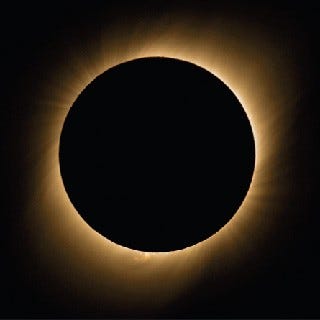The most unbelievable coincidence in the visible universe
mar 13 2023A fascinating fact about the Sun and Moon
By Marcos Chiquetto
The photo below shows a solar eclipse. The Moon is passing in front of the Sun.

If an observer is at one particular place here on the Earth, he will be able to see a complete eclipse. For several minutes the Moon will completely cover the Sun and the day will become dark.

Eclipses have always fascinated humanity and were a source of fear among ancient peoples, who sought mystical explanations for the phenomenon. Even today, eclipses are followed with great interest.

However, total solar eclipses are something that we rarely see. This is because they only occur in very small areas on the planet’s surface. I will show why this is the case with a figure.
At first I thought of drawing a figure to scale to give an idea of the real proportions, but I changed my mind as it would be impossible to see anything. Just to give you an idea, if the Sun were the size of a basketball, the Earth would be the head of a pin 30 m away and the Moon would be a speck of dust 8 cm from the head of the pin. In other words, you would just see dots in the figure. So I have produced a drawing of a solar eclipse that is not to scale.

The total eclipse is only seen in a very small area — practically a point — where the dashed lines in the figure touch the surface of the Earth (a region covering only a few hundred kilometers). In the area next to this, people will see a partial eclipse. The closer you are to the area where there is a total eclipse, the more the Moon will cover the Sun. Because of this, the Earth gets darker the closer you get to that point in the figure.
What I want to emphasize here is that the area where there is a total eclipse is practically a point. The reason for this is that the Sun and the Moon are seen from the Earth as if they were two spheres with the same diameter. In other words, the angle the Sun occupies in the sky is practically the same as the angle the Moon occupies in the sky (the angle between the two dashed lines in the figure above). Both occupy an angle of approximately half a degree (in the figure the angle is not this size because the figure is not to scale). We see the Sun and the Moon as though they were the same size.

This is illustrated in the second photo in this article, which shows the Moon exactly covering the Sun. If the Moon were seen as a sphere with a different diameter from that of the sun, the two celestial bodies would not overlap so exactly. Either the Moon would be larger than the Sun and the total eclipse would be seen in a larger area, or the Moon would be smaller than the Sun and there would never be a total eclipse.
So, the explanation is simple: everything happens in this fascinating way because the Moon and the Sun appear to be the same size for somebody looking from the Earth’s surface.
— So that’s it? Is that the end of the article?
Yes, that’s the end. Did I forget something?
— I don’t know. It all seems a bit strange…

— Hang on. So, why do these two celestial bodies have the same apparent diameter? They are completely different sizes from each other but when you look from here they seem the same! Did it really have to be like that?
Ah. Now you’ve touched on a point that’s worth mentioning. During our whole life we look at the Sun and the Moon and see that they are the same size in the sky. We are so used to this that we never stop to think about it. Did it really have to be like that? Is there some reason for it being that way?
You won’t believe it when I tell you: it’s a complete coincidence.
The diameter of the sun is approximately 1,400,000 km and the diameter of the Moon is approximately 3500 km; in other words, the Sun is 400 times bigger than the Moon. The distance from the Earth to the Moon is approximately 380,000 km, and the distance from the Earth to the Sun is 150,000,000 km, or approximately 400 times greater. The difference in the diameter is compensated for by the difference in the distance, and the result is that they both look as if they are the same size.
— I don’t believe it. The fact that the two largest celestial bodies that can be seen from the Earth look as if they were the same size is just a coincidence?
Yes. And it’s probably the most fascinating coincidence in the visible universe.

Marcos Chiquetto is an engineer, Physics teacher, translator, and writer. He is the director of LatinLanguages, a Brazilian translation agency specialized in providing multilingual companies with translation into Portuguese and Spanish.




